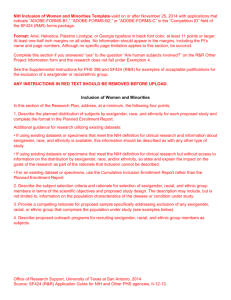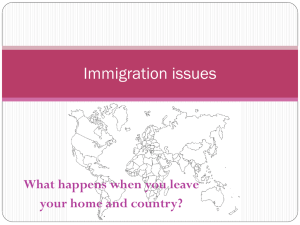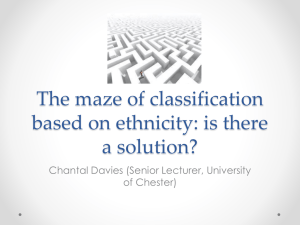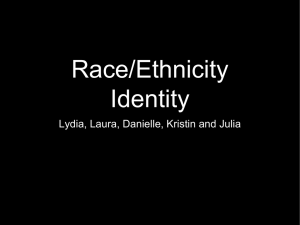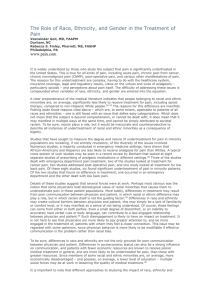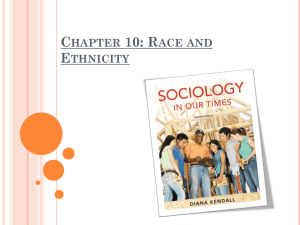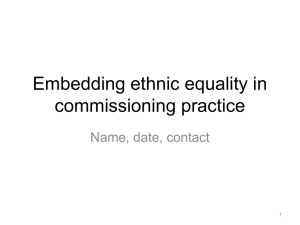Justification, Materials, Assessment, Administration
advertisement
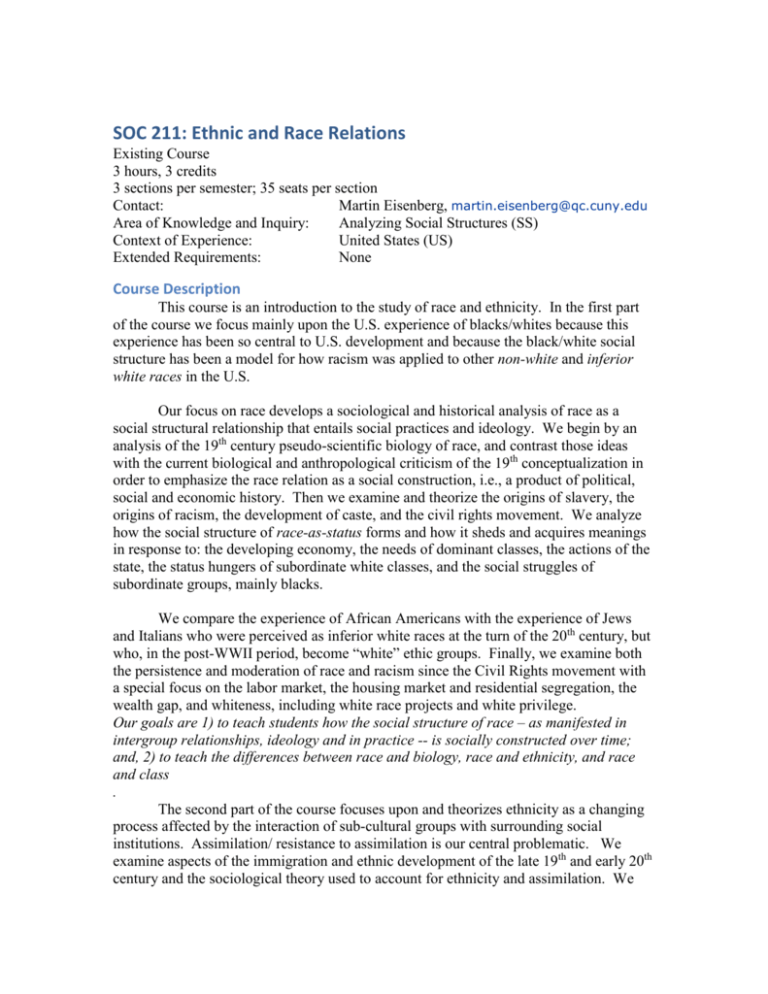
SOC 211: Ethnic and Race Relations Existing Course 3 hours, 3 credits 3 sections per semester; 35 seats per section Contact: Martin Eisenberg, martin.eisenberg@qc.cuny.edu Area of Knowledge and Inquiry: Analyzing Social Structures (SS) Context of Experience: United States (US) Extended Requirements: None Course Description This course is an introduction to the study of race and ethnicity. In the first part of the course we focus mainly upon the U.S. experience of blacks/whites because this experience has been so central to U.S. development and because the black/white social structure has been a model for how racism was applied to other non-white and inferior white races in the U.S. Our focus on race develops a sociological and historical analysis of race as a social structural relationship that entails social practices and ideology. We begin by an analysis of the 19th century pseudo-scientific biology of race, and contrast those ideas with the current biological and anthropological criticism of the 19th conceptualization in order to emphasize the race relation as a social construction, i.e., a product of political, social and economic history. Then we examine and theorize the origins of slavery, the origins of racism, the development of caste, and the civil rights movement. We analyze how the social structure of race-as-status forms and how it sheds and acquires meanings in response to: the developing economy, the needs of dominant classes, the actions of the state, the status hungers of subordinate white classes, and the social struggles of subordinate groups, mainly blacks. We compare the experience of African Americans with the experience of Jews and Italians who were perceived as inferior white races at the turn of the 20th century, but who, in the post-WWII period, become “white” ethic groups. Finally, we examine both the persistence and moderation of race and racism since the Civil Rights movement with a special focus on the labor market, the housing market and residential segregation, the wealth gap, and whiteness, including white race projects and white privilege. Our goals are 1) to teach students how the social structure of race – as manifested in intergroup relationships, ideology and in practice -- is socially constructed over time; and, 2) to teach the differences between race and biology, race and ethnicity, and race and class . The second part of the course focuses upon and theorizes ethnicity as a changing process affected by the interaction of sub-cultural groups with surrounding social institutions. Assimilation/ resistance to assimilation is our central problematic. We examine aspects of the immigration and ethnic development of the late 19th and early 20th century and the sociological theory used to account for ethnicity and assimilation. We examine a new sociological theory of assimilation that incorporates and revises the older sociological theory and is primarily a response to the “new” immigrations that begin around 1970. We compare the social conditions faced by the descendants of early and new immigrants as well as how their ideas and values changed and are changing. We compare the experience of the second generation of three different “new” ethnic groups and how their assimilation rates are affected by the diverse social, human and financial capital of their immigrant parents, U.S. laws and political institutions, and U.S. capitalism in the light of a globalized economy, the ease of international transportation and communication, and their non-whiteness. Our goal is: 1) to enable students to reflect upon the changing nature of ethnicity and why groups assimilate at different rates or resist assimilating; 2) to enable students to see the changing nature of sociological theory in relation to new experience; and, 3) given the ethnic diversity of QC, we want to provide students with some tools to reflect upon their own experience. Justification 1) Our goals are: a. to enable students to see how sociology contributes to understanding how the concept, intergroup relationship and practice of race is not based in biology; that it is not the same as ethnicity or class; and that the meaning of race changes over time as a consequence of surrounding social factors; b. to show students how sociological concepts enable them to reflect upon how ethnicity and the norms, values and ideas associated with ethnic groups are not static; ethnic sub-cultures change over time through the interaction of ethnic group members with other ethnic groups and with surrounding and changing social institutions; c. and, to show students how sociology can enable them to reflect upon their own ethnic experience. 2) Sociology emphasizes that society creates the conditions of our lives; emphasizes that humans create the world and therefore there is always a possibility for changing the world and expanding democracy; and sociology enables society to reflect upon itself theoretically. . 3) See 1) above. 4) Central comparative elements of this course include: a. comparing social conditions faced by blacks and “inferior” white races and their differential rates of social mobility over generations; b. comparing social conditions faced by new and early 20th century immigrants and their different assimilation rates; c. examining why different ethnic groups, old and new, assimilate at different rates. Global elements include situating the origins of slavery in a context of global economic trade, and the new immigration in a context of a global economy and labor mobility. 5) The course explicitly focuses upon the nature of racial and ethnic diversity and the social construction of race and ethnicity over time. 6) The students are challenged to use theory and evidence to think about, discuss in class, and write about (in 2 papers) whether racism exists and to what extent, and whether U.S. ethnic groups are assimilating or not, and why groups assimilate at different rates. In addition, we want students to be aware of how historical conditions and social change are interwoven with, and affect the development of the sociologically analytic concepts we use to examine the development and practice of race and ethnicity. Course Materials, Assignments, and Activities 1)“Statement on Race” by the American Anthropological Association. An introductory summary of the current biology of race, which argues that biological differences among human groups are insignificant, and that racism develops as an ideology to justify enslavement, conquest and colonization. 2) “Race: The Power of An Illusion: the differences among us”, a film. Extended discussion, with many clear illustrations of current knowledge about genetics, race, and why the 19th and 20th Century pseudo-scientific knowledge of race was fictional. Among many points, the film makes clear that there are as many genetic differences within so-called races, as there are between them, that there are no pure races, that physical traits are not inherited concordantly, and that external, physical characteristics of groups tell us nothing about their abilities, personalities, culture, behavior, etc. 3)”Best of Friends, Worlds Apart”, by Mirta Ojito, New York Times, an extended article that examines how the lives of two Cuban immigrant young men, one black and on white, who were close friends in Cuba grow distant when they arrive in Miami. Everything about their lives changes because the black young man faces social obstacles because he is black, which the white young man cannot conceive. The article demonstrates how the social weight of race and discrimination is much more significant than that of ethnicity. 4)”The Social Origins of Race” by Audrey Smedley discusses the origins of slavery in North America, the three ideological justifications of slavery, and how racism, the justification of slavery by reference to biological differences between whites and black develops as a response to the abolitionist challenge. 5)”Back Toward Slavery”, from Black Reconstruction by W.E.B.DuBois discusses the origins and development of the Caste/Jim Crow system after 1877 as a consequence of the needs of Big Capital/Big Landholders for cheap labor in political alliance with the needs of white workers for jobs and a sense of status superior to blacks. 6) “Status” by Max Weber is a discussion on “Status” as a phenomenon of power that refers to unequal distribution of social honor. At least one powerful group successfully claims positive social honor for itself in order to monopolize economic and political opportunity and simultaneously imposes negative social honor upon a subordinate group to exclude them from jobs and political privilege. I argue that the societalized status relationship between blacks and whites is the most useful way to understand race as a social structure that entails a relationship of domination and subordination, apart from biology and ethnicity, and apart from, although related to class. 7) “No Color Barrier: Italians, Race and Power in the U.S.” by Thomas Guglielmo argues that despite the discrimination and poverty they faced, Italian immigrants were white on arrival to the U.S. and they and their descendants had political and economic opportunities that most blacks did not possess until after the Civil Rights Movement. “The Jewish Horatio Alger Story” in The Ethnic Myth by Stephen Steinberg examines why Jewish immigrants at the turn of the 20th century achieve social mobility more quickly than other immigrants of the time. He concludes that while their norms and values are important, at least as important if not more is the skills, knowledge and experience they bring with them, the time and place of their arrival. This essay challenges the notion that a group’s “culture” is their engine of success or failure, and insists upon the recognition of the availability of economic and educational opportunity, and skills and knowledge. I use both these articles to contrast the political and economic opportunities of white immigrants and the lack of opportunities available to blacks prior to the CRM. 8) “How Did the Jews Become White Folks” by Karen Brodkin argues that Jewish Americans do not become “fully white” until after WWII with the minimization of antiSemitic and other ethnic prejudices, the expansion of the economy with government help, and the educational, housing and employment assistance provided to Jewish and all other white veterans by the federal government that was disproportionately withheld from African American veterans. Brodkin likens this to a kind of affirmative action for whites only. I use this article to emphasize that white groups do not “make it on their own”, but that they have been boosted into the middle class by the aid of the federal government. 9) “The Civil Rights Movement: A Social and Political Watershed” by Aldon Morris and Cedric Herring, emphasizes how the tripartite oppression (i.e. the Jim Crow/Caste system) of blacks is fractured by the CRM and traces the some of the high-lights of the CRM. I use this article to emphasize that social change for African Americans did not occur without intense political struggle over many years and the passage of laws against discrimination in the economy and to guarantee the right to vote. 10) “The Great Transformation” from Racial Formation in the U.S. by Michael Omi and Howard Winant emphasizes the social conditions that make the CRM possible, the origins of new social movement politics, the redefining of “black identity”, and the shift to black power. This article emphasizes how the development of racial meanings is a product of social and historical struggle. Racial Issues Since The Civil Rights Movement: is this still a racist society? 11)”An Interview” with Dalton Conley that emphasizes the racially unequal distribution of wealth, how most people accumulate wealth, why wealth is important, and the historical advantages of whites in the wealth accumulation. “Racial Inequality and African Americans’ Disadvantage in the Credit and Capital Markets” by Gary Dymski and Patrick Mason, Racial discrimination has diminished since the CRM but remains significant. 12) “Residential Segregation and Neighborhood Conditions: by Douglas Massey emphasizes the persistence of residential segregation over the last 25 years, and the ways in which it significantly advantages white people in the areas of employment, education, and the appreciation in the value of their homes. “The Downward Spiral” emphasizes the responsibility of whites and white demand for the much more rapid appreciation in the value of white homes in white areas and the much more rapid depreciation of homes in black, in contrast with homes in interracial areas that remain interracial. 13) “Race, Ethnicity and the American Labor Market” by Roberta Spalter-Roth and Terri Ann Lowenthal (for the American Sociological Association) synthesizes 91 articles on labor force participation, occupational data, displaced worker outcomes by race and ethnicity. Also, this article discusses the extent of racial and ethnic discrimination (i.e., the “veil” in the labor market), how and where it occurs, and how most people get their jobs. “Persistent Racial Discrimination in the Labor Market” by Patrick Mason. 14) “New Marriages, New Families: U.S. Racial and Hispanic Intermarriage” by the Population Reference Bureaus shows (if intermarriage is an indicator of continuing prejudice) that the rate of both black-white, and Hispanic-white intermarriage has increased significantly (i.e., racism is diminishing) but, the rate of black-white intermarriage remains quite low (i.e., racism is still very powerful). “The Unrealized American Dream” by D. Muhammed compares social indicators such as income, wealth, high school and college education, poverty, stock ownership by race. “The Central Framework of Colorblind Racism” from Racism Without Racists by Eduardo Bonilla-Silva examines the components of “color blind racism”, how whites persuade themselves they do not have racial prejudice. 15) “White Privilege: Unpacking the Invisible Knapsack” by Patricia McIntosh examines the ways in which whites as whites have social privileges that blacks as blacks do not possess. “Behind Blue Eyes: Whiteness and U.S. Politics” by Howard Winant discusses how the conflict of political visions and strategies among whites groups (“Race Projects) across the political spectrum produce and change racial meanings (along with those of black groups). “Double Consciousness and the Veil”, examines black self-consciousness in the 20th century before the CRM, and how whites see blacks through a veil that consists of the white prejudices against blacks. On Ethnic Groups 16) “Sociological Reflections in the Melting Pot, Cultural Pluralism and Assimilation” by Martin Eisenberg. Basic definitions: the melting pot, cultural pluralism, assimilation, multi-ethnicity, multi-culturalism, social indicators. Conceptual responses to immigration in the early 20th century. Robert Park’s theory of assimilation as a response to mass immigration and the critique of Park’s theory. “New Assimilation Theory: The Conceptual Framework” from Re-making The American Mainstream by Robert Alba and Victor Nee. How this theory incorporates and differs from Park’s theory, how it is a response to the new immigration, what it explains that Park’s theory cannot explain. These articles emphasize how sociological theory changes as social conditions change and with reflection upon those conditions. 17) “Rules of Capitalism” by Martin Eisenberg situates immigration in a context of global capital and global labor mobility. I use this article to argue that immigration to the U.S. serves an economic function for the U.S. and is not merely the expression of the desires of immigrants for a better life. 18) “Evidence of Contemporary Assimilation” by R. Alba and V. Nee is used to demonstrate how to use Park and Alba and Nee to assess the extent to which many different ethnic groups of the new immigration are assimilating into U.S. society although at different rates. The next eight readings focus on the second generation of three ethnic groups: Dominican-Americans, Black English-speaking Caribbean-Americans, and KoreanAmericans. We examine social indicators of assimilation in relation to each groups including: educational accomplishments, economic positions, political participation, intermarriage, residential concentration and dispersal, politics, institutional participation and development, and norms and values. We examine the factors that contribute to different rates of assimilation and to resistance to assimilation. 19)”Ethnic and Post-Ethnic Politics in New York City: The Dominican Second Generation” by Nicole Marwell. “Somewhere Between Wall Street and El Barrio: Community Colleges as a Second Chance for Second-Generation Latino Students” 20) “Jamaicans: Balancing Race and Ethnicity” by Milton Vickerman. “’We’re Just Black’: The Racial and Ethic Identitites of Scond-Generation West-Indians in New York” by Sherri-Ann Butterfield. “’Isn’t Anybody Here from Alabama’?”: Solidarity and Struggle in a ‘Mighty, Mighty Union’” by Amy Foerster. 21) “Korean Americans”: by Pyong Gap Min “Class Matters: Racial and Ethnic Identities of Working and Middle-Class Second Generation Americans in NYC”, by Sara Lee. “Ethnic Futures: Children and Intermarriage” in Becoming Asian American by Nazia Kibria. The Future of Race in the U.S.: These articles are different perspectives on the future. 22) “Black, Honorary White, White: The Future of Race in the U.S.” by E. Bonilla-Silva “Racial Justice in a Black/Nonblack Society” by George Yancy. Exams: There are three non-cumulative, multiple choice, True/False, short answer examinations. Papers: There are two 5-6 page papers. In Paper # 1, the class is asked to use the empirical evidence and theoretical material assigned in the class to answer the following question: Do Whites still exercise domination over African Americans by treating them and other Blacks as a subordinated status groups? In Paper #2, the class is asked to use the empirical evidence and theoretical material assigned in the class to answer the following questions: Is the ethnic group you have chosen to examine from among the second generation of the new immigration assimilating, resisting assimilation, or both? And, what do you believe is the future for this group in 25 years in relation to the process of assimilation? Group Presentations: The class is divided into nine groups of four individuals. Each group presents the major ideas of one of the articles about one of the ethnic groups and discusses whether the group is assimilating or not. Assessment In conjunction with Middle Sates Accreditation requirements, the department of sociology is managing a pilot program—using Social Statistics (Sociology 205)—to develop measures to gauge student outcomes for our core courses. The outcome of this pilot will provide an assessment framework that we will apply to PLAS course assessment. Administration This course will be taught by full-time and adjunct faculty members. The department’s Curriculum Committee will oversee PLAS courses and suggest and approve course modifications. To insure ongoing quality control, the department will use the Teaching Observation to evaluate pedagogy in the PLAS courses. Conducted once during the fall and spring semesters, faculty evaluators will observe each PLAS class to examine course content and to evaluate how closely the syllabus reflects PLAS goals and objectives.

